How to build an inflation-hedged stock portfolio
The ongoing global battle with inflation, along with supply chain disruptions caused by the war in Ukraine, poses a huge challenge to investors that seek to hedge their inflation risk. Naturally, the global bond market has been on the front line of the present correction. However, equities are not immune either, and we have already seen bear market conditions for high multiple growth stocks in technology and other premium corners of the market.
It is more than ten years since I last ran a global food and agriculture portfolio but the market has not greatly altered in that time. The blessing of the food sector is that many producers keep on going, through thick and thin, so the rotation of companies is not that high.
Global food stocks such as Nestle (NESN.S), McDonald's (MCD.N), or General Mills (GIS.N), may seem boring, but in times of rapidly rising prices, this can be one of the relatively few places you can find stocks that are going up at this time.
The other obvious sector is energy, and agricultural chemicals, such as fertilizer and pesticides. These generally display strong inflation protection characteristics for the simple reason that it is the rising price of food, fuel and agricultural inputs that drive the fastest-changing areas of the consumer price inflation basket.
As I write this, the Australian headline CPI rate for the twelve months to March 2022 was just released by the ABS - the number was 5.1%!
Such high rates of inflation raise the nominal return target we must hit to break even against the drag of rising prices. The best way I know to hedge that risk is to look for companies that experience rising prices for the products they are selling. This is elementary, of course.
One needs to find the firms with pricing power and sustained profit margins.
In times such as this, the primary producer end of the supply chain tends to see the benefit of rising prices first. The wave of rising prices moves down from seller to buyer, along the supply chain until it reaches the end consumer. Generally speaking, there is a lag between higher prices at the front of the supply chain and the final consumer-facing end of that chain.
Within agriculture, the front end of the chain consists of farming companies, and their inputs such as fertilizer, pesticides and farm machinery. The prices of the latter tend to follow the price of fuel, via petrol and diesel, chemicals via natural gas, and metals for machinery.
Primary producers are more inflation sensitive than the branded food exposures I mentioned above. Through changing the portfolio allocation between companies across the length of the supply chain from the primary producer through to the consumer, we can dial the cyclical exposure up or down, and suitably hedge our inflation risk.
Throughout, we need to remember that agriculture is a cyclical business, and so a period of rising prices is usually followed by a period of plateauing, or even falling prices. The casual investor should be forewarned that farming operations, fertilizer companies, and grains processing and trading companies, are volatile. Consider your own risk appetite.
At Jevons Global, we use a rigorous process to construct thematic portfolios. The idea is to first survey the full global opportunity set of investible companies, and then to cut that down through a series of steps into a target portfolio. The starting point is to use a database to screen for all stocks that meet a rules-based definition of food and agriculture.
For my data service, this produced a list of over 3,000 stocks worldwide on pretty much every stock exchange. This is unwieldy and impractical since there are many stock exchanges that are illiquid, or simply inaccessible (take Russia, due to sanctions, or India for foreigners).
The filters we applied were:
- a minimum market capitalization of $500M USD
- a minimum one-year average daily volume of $1M USD of trade per day
- a reduced list of readily accessible developed market exchanges plus Mexico
It might seem odd to include Mexico, but it is easy to buy stocks on that exchange for most online brokerage accounts. Other emerging markets are more difficult, but can be bought sometimes through so-called cross-listings or "depositary receipts". I left these out.
With those filters, we get the following universe of stocks to look at:
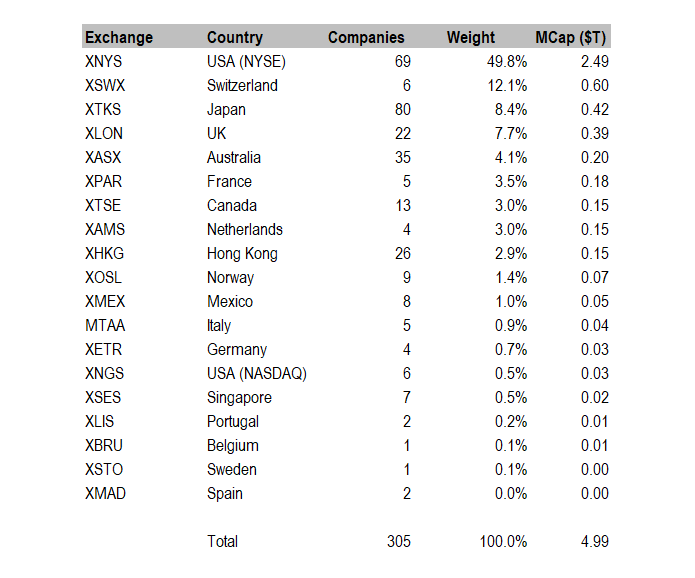
Obviously, 300 stocks is way too many. We will cut that down to around twenty. However, the basic look of things is relatively sensible. The USA is around half the total market capitalization (here in trillions of USD), which is similar to the broad global market. We can also see that Switzerland, Japan, the United Kingdom, Australia and France are well represented.
Another useful way to look at the opportunity is to divide up the stocks according to their place in the supply chain. I knocked up a classification for all the companies below.
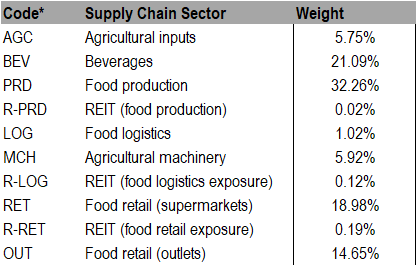
There are some real estate investment trust classifications in there for some of the Australian stocks, but you can mostly ignore those. The key front of the supply chain piece is labelled food production (PRD), although it is not simply farming. It includes food manufacturing.
Some of this is vertically integrated, or largely consumer-facing, like Nestle, but you can get the basic idea that there is a large chunk of this opportunity that is genuinely food.
Other large areas are food retail (which dominates the market in Australia), beverages, and food retail outlets, which include restaurants and other food-service companies.
Agricultural inputs contains fertilizer and pesticide companies, while agricultural machinery has tractor companies and other farm-related equipment firms. Some of these also make trucks, and other heavy equipment, so one needs to be selective in looking into the product lineup.
Let's illustrate with some examples.
Agricultural sector
In the Australian agricultural sector, the principal exposures are:
Graincorp (GNC.AX) operates a grains handling and trading business for Australian wheat and oilseeds. They also own similar operations in Canada and some elsewhere.
Incitec Pivot Ltd (IPL.AX) manufactures and distributes fertilizers and explosives through the Dyno Nobel business.
Nufarm Ltd (NUF.AX) which operates in the crop protection and seeds business
These businesses have moved from a relatively long period of indifferent financial results into a purple patch of higher underlying demand and increased pricing power. That is a function of greatly improved domestic cropping conditions post the breaking of the Australian drought with a second wind to the upcycle following higher soft commodity pricing worldwide.
When looking at the front of the global supply chain, there are four principal areas in which agricultural investors typically play. In brief, these are:
- Agricultural equipment plays such as tractors and farming machinery
- Primary producers that run cropping operations or produce meat and livestock
- Agricultural inputs producers active in seeds, crop protection and or fertilizers
- Soft commodity trading houses that buy, store, process, and sell soft commodities
Australia has a presence in the last three, but not agricultural machinery.
Agricultural machinery
The main global agricultural equipment firms are
Deere (DE.N) which produces the John Deere brand of tractors and other farm equipment
AGCO (AGCO.N) which produces brands such as Massey Ferguson, and Valtra
CNH Industrial NV (CNHI.MI) which produces Case New Holland, Steyr and other brands
Primary production
Primary production firms are less likely to be listed, and often not available on the more easily accessible exchanges. In places like Australia there are more of them:
Australian Agricultural Company (AAC.AX) which is a pastoral company
Select Harvests (SHV.AX) which produces nuts
Costa Group (CGC.AX) which mainly produces avocadoes
Tassal Group (TGR.AX) which produces farmed salmon
Inghams Enterprises (ING.AX) which farms poultry
There are others I won't go into, but that range is actually pretty broad globally. Other good places to look for listed primary producers are the USA and Singapore.
US names
Finally, to round out the scope of front-end exposures it is worth mentioning some USA listed companies that are go-to places for exposure when soft commodities run hot. These are the grain trading firms, that buy, sell, store and process grains, and the fertilizer companies.
Archer Daniels Midlands ADM.N is the leading US grain trading firm
Bunge BG.N is another US grain trader that is very active in Latin American markets
Mosaic MOS.N is a leading USA based producer of potash
Nutrien NTR.TO is the leading integrated farm service and chemicals firm in North America
CF Industries CF.N specializes in natural gas derived ammonia fertilizers and hydrogen
There are others, but one can build effective portfolio exposure to fertilizers with those alone.
Once we are familiar with the global investment landscape, it is not too difficult to build a solid diversified food and agriculture portfolio. Here is one I prepared earlier.
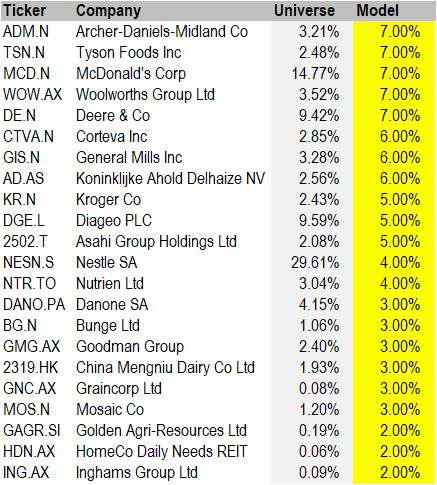
That is the portfolio. Your risk appetite and circumstances may differ. Furthermore, I have not gone into any detail about why I selected these twenty-two stocks from three hundred.
The purpose in sharing this example is to highlight how a nebulous thematic like global food and agriculture can be developed, in stages, into a well-diversified and risk-managed portfolio.
The hot tip in such work is to make sure you adjust your portfolio weights to avoid crowding into one or other corner of: the "world"; or the "supply chain"; or "firm size".
There is a bit of black art to building such portfolios. This comes with practice, as the normal methods of portfolio optimization will generally give unworkable corner solutions.
To see what I mean, let's look at the resulting portfolio structure.
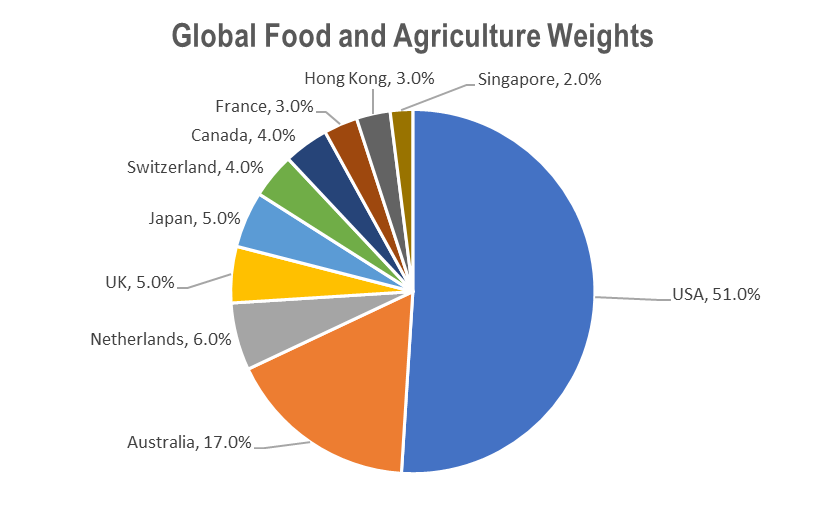
Notice that the weight in the USA is very similar to the overall universe, but we have reduced Switzerland and Japan some to up weight Australia. In my global investing work, I generally find that a roughly 20% Australian allocation provides good natural hedging when combined with global stocks, but that there is not much reward for changing the USA weight.
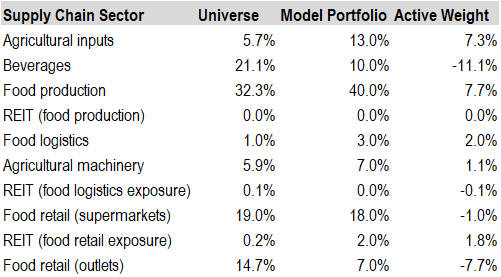
When we look at the detailed weights for the different stages of the supply chain you can see that the portfolio is overweight agricultural inputs, such as fertilizer, and food production. To fund that positioning, we are underweight food retail outlets (restaurants) and beverages.
Note that this kind of "bet" follows from "how much" of each stock we own. By changing the weights, without changing the stock picks, I could have expressed a reverse outlook.
The one remaining question to ask is the obvious one:
Why bother? Does any of this fiddling ever make a difference?
Here is the passive performance over the (short) period since the end of 2021,

and here is the active result after reducing the 300+ stocks down to just twenty-two

There is a big performance difference between these two portfolios even though the country exposures are not greatly different. The bulk of that is attributable to a combination of the underlying stock selection and the supply chain positioning.
Of course, this is not a real performance record, but when building the portfolios, I used the supply chain tilt, along with relative valuation, and position sizing to manage risk.
Thematic investing involves a bit of a knack in knowing how to blend the macroeconomic outlook with the bottom-up stock selection, but the principles are not that hard.
I have written this walk-through example to help readers better understand how thematic investors think and work. In my experience, it is a really good way to figure out how to move your portfolio allocation when markets start to change radically, as they are now.
Just remember my one hot tip:
The weights you choose are just as important as the stocks.
Like any investor, my biggest mistake has always been the exact same one:
Own too much of the thing going down and not enough of the thing going up!
Thinking thematically helps create a framework for working through that question.
Happy investing and may good fortune come your way.
Disclosure: the author has an interest in: Woolworths; Graincorp; Mosaic; Nutrien; Bunge; and Archer Daniels Midland.
If you like this approach to markets please follow me.
Never miss an insight
Enjoy this wire? Hit the ‘like’ button to let us know. Stay up to date with my content by hitting the ‘follow’ button below and you’ll be notified every time I post a wire. Not already a Livewire member? Sign up today to get free access to investment ideas and strategies from Australia’s leading investors.
2 topics
3 stocks mentioned

